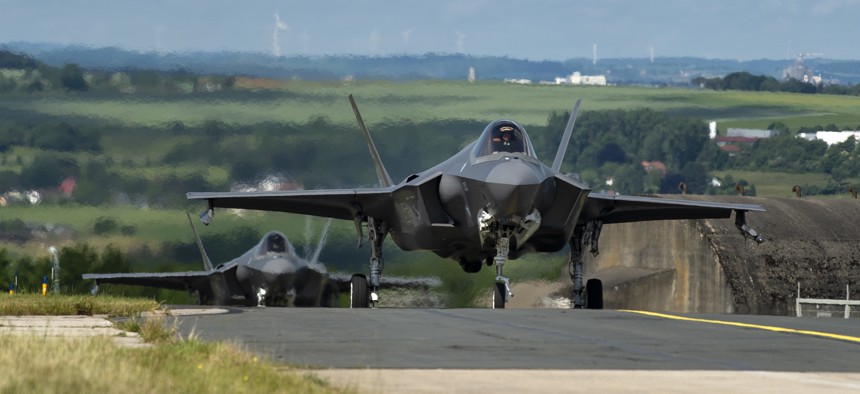
U.S. Air Force F-35A Lightning II fighter aircraft, assigned to the 421st Fighter Squadron, Hill Air Force Base, Utah, taxi on the flightline at Spangdahlem Air Base, Germany, June 11, 2019. U.S. Air Force / Airman 1st Class Valerie Seelye
Pentagon, Lockheed Martin Failed to Ensure Proper Parts for F-35
Watchdog questions adherence to contracts and performance incentives for Defense’s largest buy.
A major contractor and the Pentagon’s top management office came in for criticism from an inspector general for cutting corners in assuring that the massive joint-service F-35 stealth fighter is equipped with ready-for-issue parts.
In a report dated June 13, the Defense Department watchdog found that parts for the department’s largest acquisition—with an estimated $406 billion price tag and sales planned to foreign allies—were not being received according to the contracts and performance incentives.
The parts contracted for delivery by Lockheed Martin Corp. include wheel, seat, and window assemblies, said the audit addressed to the Defense secretary for acquisition, the Air Force secretary, the Air Force inspector general and the Defense Contract Management Agency. The federal contracting offices and the corporate teams working on the plane are supposed to ensure the sustaining parts are delivered “ready for aircraft maintenance personnel to install on the aircraft,” as well as have an Electronic Equipment Logbook assigned that spells out each part’s history and remaining life.
Too often, however, the parts arrived not ready in accordance with contracts and incentive fees on the sustainment contracts because of “inflated and unverified F‑35A aircraft availability hours. This occurred because the [Joint Program Office] did not conduct adequate oversight of contractor performance related to receiving F‑35 spare parts and aircraft availability hours,” the report said, calling the inflation of hours unintentional.
Related: Pentagon Gives Turkey a Deadline to Cancel S-400 Deal or Lose F-35
Related: The F-35 Is About to Get A Lot Smarter
Related: Price Drop: Lockheed Pitches $80M F-35A to Pentagon
As a result, the department received non-ready spare parts and spent up to $303 million in labor costs since 2015, “and it will continue to pay up to $55 million annually” for such parts until a fix is made. In addition, the Defense Department has “potentially overpaid” $10.6 million in performance incentive fees by not independently collecting and verifying aircraft availability hours.
“The lack of available [ready-for-issue] spare parts could result in the F‑35 fleet being unable to perform required operational and training missions,” the report warned.
The Joint Program Office was aware of the problem, auditors found during their review from June 2018 to April 2019, but did not resolve the issue or require the services to better track the non-compliant parts. Interviews with the Joint Program Office staff in Arlington, Va.; the DCMA administrative office in Lockheed Martin’s facility in Fort Worth, Texas; and Lockheed staff at three sites found, for example, that of 74 spare parts delivered to Hill Air Force Base in Utah from Sept. 17-30, 2018, 59 spare parts (80 percent) were non-ready for issue. Of the 263 spare parts delivered to Luke Air Force Base in Arizona in June 2018, 213 spare parts (81 percent) were non‑ready. And of 132 spare parts delivered to the Marine Corps Air Station in Beaufort, S.C., in September 2017, 58 spare parts (44 percent) were non‑ready.
The IG recommended that the F-35 program executive officer improve oversight by coordinating with DCMA to pursue compensation from the contractor for the costs of mishandling the supply of spare parts since 2015. It also recommended that he direct the contracting officer to add clarifying language to future sustainment contracts, and task the lead contracting office with updating its Quality Assurance Surveillance Plan.
Navy Vice Adm. Mathias Winter, the program executive, agreed, stating that there is value added in tracking and using contractor performance data.
